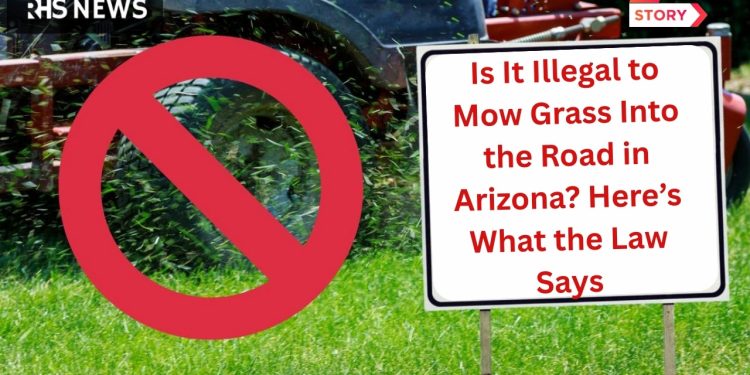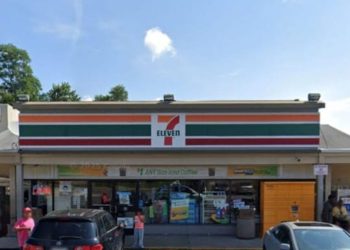Arizona – Maintaining a neat lawn in Arizona’s cities—whether in Phoenix, Tucson, Mesa, Chandler, Scottsdale, Glendale, or smaller communities like Prescott and Sierra Vista—comes with responsibilities that extend beyond the property line. One persistent question for homeowners, HOAs, and landscaping crews is whether blowing or mowing grass clippings into the road is illegal in Arizona.
The short answer: leaving debris, including grass clippings, on public roads can violate Arizona law, carry penalties, and create real safety hazards for motorists and motorcyclists. Here’s a complete breakdown of what the law says, how it’s enforced, and best practices to stay compliant and safe across Arizona communities.
What Arizona Law Says About Debris on Roads
Arizona does not have a statute that names “grass clippings” specifically, but state law broadly prohibits dumping or leaving “refuse, rubbish, debris… or other trash” on state or county highways, public roads, or within 20 yards of them.
This is codified under Arizona law as dumping trash on highways and is classified as a misdemeanor offense. Practically, this can include lawn debris blown or left in roadways after mowing near curbs, alleys, and right-of-way areas in cities like Phoenix, Peoria, Tempe, or Gilbert, because grass clippings qualify as “debris” or “other trash” under the statute’s broad language.
If the dumping is done from a vehicle—such as using a blower from a truck or mowing rig—the driver is presumed to be the offender, which is important for landscaping businesses operating in cities like Surprise, Avondale, Queen Creek, or Goodyear. Enforcement can come from state highway patrol, county sheriffs, or city police, and the statute also directs agencies to post signage reminding the public that dumping debris is unlawful on roads, public airports, and thoroughfares
How This Applies in Phoenix, Tucson, and Other Cities
Even though the state statute is general, Arizona cities commonly apply it to yard waste and roadway safety. In urban neighborhoods across Phoenix, Tempe, Chandler, Mesa, and Scottsdale, mowing that discharges clippings across sidewalks and into the street can leave a slick film on asphalt—especially hazardous when combined with irrigation overspray or monsoon moisture.
The legal exposure increases near intersections, bike lanes, and known motorcycle routes in Tucson and Flagstaff where visibility and traction are critical. While local ordinances may vary, the state debris statute gives law enforcement a clear basis to cite roadside dumping of clippings that reach the pavement.
Why Grass Clippings on Roads Are a Real Safety Hazard
Grass clippings behave like a low-friction layer between tires and pavement, creating a skid risk similar to loose gravel or a thin sheet of moisture. Motorcyclists are especially vulnerable—clippings on curves, roundabouts, and lane merges in cities like Scottsdale, Oro Valley, Fountain Hills, and Sedona can force riders to brake abruptly, change lines, or cross center markings to avoid a wipeout.
Road debris contributes to more than 1,000 accidents each year in Arizona, underscoring why agencies and courts take roadway hazards seriously, regardless of whether the debris began as “yard waste” or “trash”. Even where clippings aren’t the sole cause of a crash, they can contribute to unsafe road conditions—opening the door to negligence claims against the party who left them behind.
Liability Exposure for Homeowners and Landscapers
If clippings left on the street contribute to a collision—say, a motorcycle spill in Peoria or a bicyclist crash in Tempe—the responsible party could face civil liability, and in some circumstances, a citation under Arizona’s debris law.
For landscaping companies servicing neighborhoods in Glendale, Buckeye, and Maricopa, the presumption clause in Arizona law is critical: if clippings are discharged from a vehicle, the driver is presumed to be the offender, which could implicate company policies, training, and insurance coverage. Personal injury firms in Arizona routinely evaluate these facts when assigning fault in road debris cases, including whether the debris came from private citizens, commercial vehicles, or public entities.
What ADOT Expects Near Highways and Rights-of-Way
Arizona Department of Transportation vegetation guidelines for roadside mowing make one principle explicit: adjoining pavement should be left free of debris and cuttings.
These guidelines, used along highways and major corridors into cities like Phoenix, Casa Grande, Yuma, and Kingman, direct mowing crews to operate equipment in a way that avoids throwing rocks and debris onto the roadway and to clean around signs and guardrails without leaving material on the travel surface.
The standards reinforce operational best practices that local governments and private contractors can mirror on city streets and neighborhood edges to avoid roadway hazards.
Examples of Where Problems Arise
-
Neighborhood edges and curbs in Phoenix, Gilbert, and Queen Creek where mower chutes aim toward the street and blow clippings across the asphalt during edging passes.
-
HOA-maintained entries in Chandler or Mesa where contractors mow medians and push cuttings into active lanes during peak hours, leaving slick patches on hot pavement after irrigation cycles.
-
Rural transitions near Prescott Valley or Sierra Vista where roadside mowing along county roads drops windrows into the lane, especially after monsoon storms when clippings mat and adhere to the surface.
Environmental and Drainage Considerations
Beyond safety, clippings in the street can wash into storm drains during monsoon rains—a concern in Tucson and Scottsdale where stormwater systems connect to washes and retention basins. While the specific enforcement hook in Arizona often comes through the debris/dumping statute, municipalities around the country also cite stormwater and clean water compliance when restricting clippings in streets because nutrient-rich yard waste can impair water quality and clog drainage. This rationale frequently informs city policies and HOA rules across the Valley and Pima County.
Penalties and Enforcement Reality
Under Arizona law, dumping debris on highways and public roads is a class 3 misdemeanor, which can carry fines and a criminal citation, depending on circumstances and local enforcement policies. If the clippings are traced to a specific vehicle or crew—common with contractor-branded trucks in Glendale or Tempe—the presumption clause streamlines enforcement. In crash cases, law firms also pursue civil claims for negligence, with liability depending on whether the debris caused or contributed to unsafe conditions and whether the responsible party failed to exercise reasonable care in preventing material from entering the roadway.
Best Practices for Homeowners and HOAs
-
Redirect mower discharge away from streets and sidewalks; use a mulching setting or bag clippings to prevent ejection into roadways in Phoenix, Peoria, and Chandler neighborhoods.
-
Blow clippings back onto the lawn or into collection piles rather than into the curbline where they can migrate into travel lanes or storm drains in Mesa, Scottsdale, and Tempe.
-
After edging near curbs, make a final cleanup pass to remove any debris from the asphalt—especially important on sloped streets and near school zones in Surprise and Glendale.
-
Schedule mowing to avoid monsoon downpours; wet clippings are more likely to stick and create slick surfaces in Tucson and Oro Valley.
-
For HOAs in Gilbert, Queen Creek, and Goodyear, include “keep pavement free of clippings” language in vendor contracts and community standards to align with safety and ADOT best practices.
Best Practices for Landscapers and Contractors
-
Train crews to avoid directing discharge toward traffic; fit chute blockers or mulching kits on mowers used along collector roads and arterials in Phoenix, Mesa, and Scottsdale.
-
Equip trucks with blowers and brooms for immediate cleanup of any material that reaches the road surface in Chandler, Tempe, and Glendale.
-
Operate equipment at speeds that don’t throw material onto pavement; this is explicitly recommended in ADOT mowing guidance and helps avoid citations and claims statewide.
-
Implement pre-departure checks: scan for rocks and debris and verify curbs and lanes are cleared before leaving each job in Peoria, Avondale, and Surprise.
-
Document cleanup with time-stamped photos at high-traffic sites near schools, parks, and intersections in Tucson and Phoenix to mitigate liability in the event of a complaint or claim.
What To Do If Clippings Are in the Road
-
For residents in Phoenix, Scottsdale, and Chandler, report recurring issues to neighborhood services or non-emergency police lines, citing roadway debris and potential hazard to bicyclists and motorcyclists, which aligns with the state’s prohibition on dumping debris on roads.
-
For motorcyclists in Tucson, Flagstaff, and Prescott, slow before patches of visible clippings, avoid abrupt lean angles on curves with green film, and report hazardous accumulations, especially near intersections and roundabouts where crashes are more likely.
-
For HOAs in Mesa, Gilbert, and Queen Creek, coordinate with vendors to set seasonal schedules that avoid mowing just before forecast monsoon storms and ensure curb-to-curb clearance after every service.
How Insurance and Liability Are Often Resolved
In debris-related crashes on Arizona roads, claim pathways depend on identifying the source of the debris and showing causation. Attorneys evaluate whether the debris came from an identifiable party—like a residential crew in Glendale or a municipal operation in Phoenix—or whether the hazard was unavoidable and the responsible party failed to remove it in a timely way. Where the source is known, liability typically follows the actor who left or allowed debris on the road; where the source is unknown, motorists often must pursue coverage through their own policies, including uninsured/underinsured motorist provisions, while agencies review maintenance logs and response times in areas like Tucson and Yuma.
Key Takeaways for Arizona Property Owners and Crews
-
Leaving grass clippings and yard debris on Arizona public roads can violate state law prohibiting dumping debris on highways and public thoroughfares, a class 3 misdemeanor that can be enforced by police, sheriffs, and highway patrol.
-
ADOT’s mowing standards make clear that adjoining pavement should be left free of debris and cuttings, and equipment should not throw material onto the roadway—good practice for both public and private crews across Phoenix, Tucson, and all Arizona cities.
-
Clippings pose real safety risks, especially to motorcyclists, and road debris contributes to more than 1,000 crashes annually in Arizona, raising the likelihood of negligence claims if clippings cause or contribute to a collision in places like Scottsdale, Mesa, or Glendale.
-
Landscaping companies and homeowners can reduce legal and safety risks by changing mowing direction, bagging or mulching, cleaning the curbline, and documenting post-mow roadway conditions, especially before monsoon storms statewide.
Bottom Line
In Arizona, mowing or blowing grass clippings into the road is not just a bad habit—it can run afoul of statewide debris-dumping laws, trigger citations, and expose homeowners and landscaping companies to liability if a crash occurs. Across Phoenix, Tucson, Scottsdale, Mesa, Chandler, Glendale, and beyond, the safest and most compliant approach is simple: keep clippings off the pavement, clean up anything that reaches the roadway, and follow ADOT-aligned mowing practices that keep adjoining pavement debris-free.










